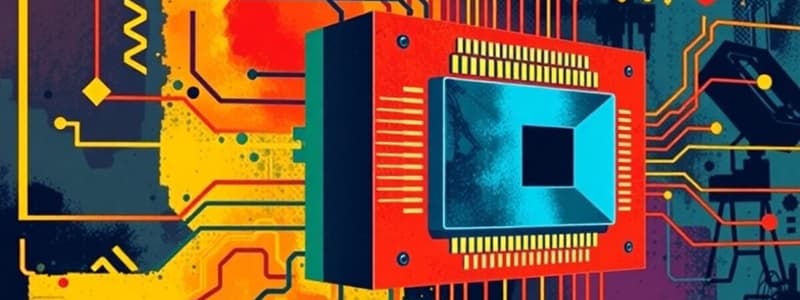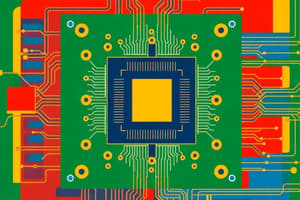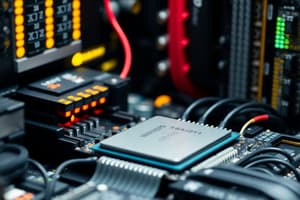Podcast
Questions and Answers
What is the main function of the motherboard in a computer?
What is the main function of the motherboard in a computer?
- Stores the operating system and user files
- Executes instructions and performs calculations
- Provides a platform for connecting all components and manages communication between them (correct)
- Displays data and graphics to the user
Which of the following is NOT a type of secondary storage?
Which of the following is NOT a type of secondary storage?
- Hard Drive
- Solid-State Drive
- Random Access Memory (RAM) (correct)
- Optical Disc
What is the purpose of the fetch-execute cycle?
What is the purpose of the fetch-execute cycle?
- To execute instructions and perform computations (correct)
- To convert instructions into a form the CPU can understand
- To transfer data between the CPU and memory
- To manage the flow of data between input and output devices
What is the role of the clock in a CPU?
What is the role of the clock in a CPU?
What is the primary function of the BIOS?
What is the primary function of the BIOS?
Which of the following factors contributes to the speed of a CPU?
Which of the following factors contributes to the speed of a CPU?
What is the role of the instruction pipeline in a CPU?
What is the role of the instruction pipeline in a CPU?
Which of the following is NOT a common type of secondary storage?
Which of the following is NOT a common type of secondary storage?
Which of the following protocols is responsible for ensuring reliable data delivery in the Internet protocol suite?
Which of the following protocols is responsible for ensuring reliable data delivery in the Internet protocol suite?
What is the primary function of the Data Link layer in the network model?
What is the primary function of the Data Link layer in the network model?
What does the acronym 'URL' stand for in the context of the Internet?
What does the acronym 'URL' stand for in the context of the Internet?
Which of the following services is NOT primarily accessed through the Internet?
Which of the following services is NOT primarily accessed through the Internet?
What is the role of the Domain Name System (DNS) in the Internet?
What is the role of the Domain Name System (DNS) in the Internet?
Which of the following best describes the 'client-server' model in the context of the World Wide Web?
Which of the following best describes the 'client-server' model in the context of the World Wide Web?
What is the primary purpose of the Hypertext Transfer Protocol (HTTP)?
What is the primary purpose of the Hypertext Transfer Protocol (HTTP)?
Which of the following is NOT considered a key component of the Internet protocol suite (TCP/IP)?
Which of the following is NOT considered a key component of the Internet protocol suite (TCP/IP)?
Which layer of the operating system model is responsible for managing communication sessions between applications?
Which layer of the operating system model is responsible for managing communication sessions between applications?
What is the primary purpose of the hardware layer in the operating system model?
What is the primary purpose of the hardware layer in the operating system model?
Which of the following is an example of an application layer service?
Which of the following is an example of an application layer service?
What is the role of the operating system (OS) layer in the execution of a simple web browser request?
What is the role of the operating system (OS) layer in the execution of a simple web browser request?
Which layer is directly responsible for formatting data for transmission and reception?
Which layer is directly responsible for formatting data for transmission and reception?
In the OSI seven-layer model, which layer is responsible for managing the network interface to send and receive data over the internet?
In the OSI seven-layer model, which layer is responsible for managing the network interface to send and receive data over the internet?
Which layer of the operating system model is directly responsible for providing a platform for users to run applications?
Which layer of the operating system model is directly responsible for providing a platform for users to run applications?
Which layer handles issues like data segmentation and error control during data transmission?
Which layer handles issues like data segmentation and error control during data transmission?
Which protocol is responsible for routing packets between devices on the internet?
Which protocol is responsible for routing packets between devices on the internet?
What is the primary function of a gateway in a network?
What is the primary function of a gateway in a network?
Which of these protocols is NOT part of the TCP/IP suite?
Which of these protocols is NOT part of the TCP/IP suite?
What is the purpose of the Program Counter (PC)?
What is the purpose of the Program Counter (PC)?
Which of the following is NOT a characteristic of TCP?
Which of the following is NOT a characteristic of TCP?
What is the primary difference between registers and main memory?
What is the primary difference between registers and main memory?
What is the main advantage of using VoIP over traditional phone lines?
What is the main advantage of using VoIP over traditional phone lines?
Which of these protocols is responsible for the reliable delivery of data over the internet?
Which of these protocols is responsible for the reliable delivery of data over the internet?
Which of the following is NOT a reason why the CPU uses registers?
Which of the following is NOT a reason why the CPU uses registers?
What is the role of the Arithmetic Logic Unit (ALU) in executing an addition instruction?
What is the role of the Arithmetic Logic Unit (ALU) in executing an addition instruction?
What is the main purpose of ICMP?
What is the main purpose of ICMP?
Which layer of the OSI model do gateways primarily operate at?
Which layer of the OSI model do gateways primarily operate at?
Which type of memory is volatile and loses its contents when the computer is turned off?
Which type of memory is volatile and loses its contents when the computer is turned off?
How does the CPU interact with the outside world?
How does the CPU interact with the outside world?
Which of the following is an example of a special-purpose register?
Which of the following is an example of a special-purpose register?
Why is it necessary for the CPU to copy data and instructions from main memory into registers before processing them?
Why is it necessary for the CPU to copy data and instructions from main memory into registers before processing them?
Which of the following is NOT a component of the system bus?
Which of the following is NOT a component of the system bus?
How does a larger cache improve CPU performance?
How does a larger cache improve CPU performance?
What is the primary function of a CPU core?
What is the primary function of a CPU core?
Which of the following is NOT a benefit of using multiple cores in a CPU?
Which of the following is NOT a benefit of using multiple cores in a CPU?
How does a computer represent information using binary code?
How does a computer represent information using binary code?
What is the role of electricity in the functioning of a computer?
What is the role of electricity in the functioning of a computer?
Which of the following best describes how a CPU processes information?
Which of the following best describes how a CPU processes information?
What is the relationship between the CPU and the cache?
What is the relationship between the CPU and the cache?
Flashcards
Input Devices
Input Devices
Devices that allow users to enter data into a computer, such as keyboard and mouse.
Output Devices
Output Devices
Devices that display or produce data from a computer, like monitors and printers.
Motherboard
Motherboard
The main circuit board of a computer that connects all components and contains the BIOS.
Fetch-Execute Cycle
Fetch-Execute Cycle
Signup and view all the flashcards
Clock in CPU
Clock in CPU
Signup and view all the flashcards
Clock Speed
Clock Speed
Signup and view all the flashcards
Secondary Storage
Secondary Storage
Signup and view all the flashcards
Instruction Pipeline
Instruction Pipeline
Signup and view all the flashcards
Registers
Registers
Signup and view all the flashcards
General-purpose registers
General-purpose registers
Signup and view all the flashcards
Special-purpose registers
Special-purpose registers
Signup and view all the flashcards
Program Counter (PC)
Program Counter (PC)
Signup and view all the flashcards
Memory in a CPU
Memory in a CPU
Signup and view all the flashcards
ALU
ALU
Signup and view all the flashcards
RAM
RAM
Signup and view all the flashcards
ROM
ROM
Signup and view all the flashcards
CPU core
CPU core
Signup and view all the flashcards
Cache
Cache
Signup and view all the flashcards
System bus
System bus
Signup and view all the flashcards
Data lines
Data lines
Signup and view all the flashcards
Address lines
Address lines
Signup and view all the flashcards
Control lines
Control lines
Signup and view all the flashcards
Binary code
Binary code
Signup and view all the flashcards
Electricity
Electricity
Signup and view all the flashcards
Transport Layer
Transport Layer
Signup and view all the flashcards
Network Layer
Network Layer
Signup and view all the flashcards
Data Link Layer
Data Link Layer
Signup and view all the flashcards
Physical Layer
Physical Layer
Signup and view all the flashcards
IP Address
IP Address
Signup and view all the flashcards
URL
URL
Signup and view all the flashcards
HTTP
HTTP
Signup and view all the flashcards
Client-Server Model
Client-Server Model
Signup and view all the flashcards
Three-way handshake
Three-way handshake
Signup and view all the flashcards
TCP/IP
TCP/IP
Signup and view all the flashcards
IP
IP
Signup and view all the flashcards
WiFi
WiFi
Signup and view all the flashcards
VoIP
VoIP
Signup and view all the flashcards
Gateway
Gateway
Signup and view all the flashcards
Operating System (OS)
Operating System (OS)
Signup and view all the flashcards
Application Layer
Application Layer
Signup and view all the flashcards
Hardware Layer
Hardware Layer
Signup and view all the flashcards
User Layer
User Layer
Signup and view all the flashcards
Layer Model of a Computer System
Layer Model of a Computer System
Signup and view all the flashcards
Networking Services
Networking Services
Signup and view all the flashcards
Memory Management
Memory Management
Signup and view all the flashcards
Web Browser Interaction
Web Browser Interaction
Signup and view all the flashcards
Study Notes
Computer Systems Overview
- A computer system is a collection of interconnected components working together to process data and generate output.
- Key components include the CPU, memory, storage, and input/output (I/O) devices.
Von Neumann Architecture
- A conceptual model for computer systems, first proposed in the 1940s.
- Four-stage process: Fetch, Decode, Execute, Store.
CPU
- Stands for central processing unit.
- The "brain" of the computer system, responsible for processing data and instructions.
- Main components: Control Unit and Arithmetic Logic Unit (ALU).
- Arithmetic Logic Unit (ALU) performs arithmetic and logical operations.
Registers
- High-speed storage locations used by the CPU to store data and instructions.
- Faster than main memory (RAM).
- Different types with specific purposes: general-purpose, special-purpose (e.g., program counter).
Program Counter (PC)
- Stores the address of the next instruction to be executed.
- Incremented after each instruction.
Memory
- Stores data and instructions needed by the CPU.
- Typically slower than registers.
- Types: RAM (volatile) and ROM (non-volatile).
Input/Output Devices (I/O)
- Allow the computer to interact with the external world.
- Input devices allow user input (e.g., keyboard, mouse).
- Output devices display or produce data (e.g., monitor, printer).
Motherboard
- The main circuit board of a computer.
- Connects all other components (CPU, memory, storage, I/O devices).
Secondary Storage
- Non-volatile memory; stores data even when the computer is turned off.
- Examples: hard drives, solid-state drives, optical discs, magnetic tape.
Fetch-Execute Cycle
- The process by which the CPU executes instructions.
- Four stages: Fetch, Decode, Execute, Store.
Clock
- Generates regular pulse signals to synchronize instruction execution.
- Speed is measured in Hertz (Hz). A faster clock speed typically means a faster CPU.
Bus
- A set of electrical wires allowing components to communicate.
- Three types: Data lines, Address lines, Control lines.
Binary Code & Electrical Signals
- Binary code uses 0s and 1s to represent information.
- Electrical signals, such as high voltage (1) and low voltage (0), represent binary values.
Electricity and Electrons
- Electricity is the flow of electrons.
- Electrons are negatively charged particles.
- The flow of electrons is electric current.
- Voltage represents the electrical potential difference between points in a circuit.
Electric Current
- Rate of flow of electric charge through a conductor.
- Measured in amperes (amps).
Voltage
- Electrical potential difference between two points in a circuit.
- Measured in Volts.
- Higher voltage signals typically represent stronger signals
Transistors
- Semiconductor devices used for amplification and switching electronic signals
- Fundamental building blocks in CPUs (central processing units)
- Used in logic gates
Resistors and Resistance
- Electrical components that restrict current flow.
- Measured in ohms (Ω).
- Varying resistance allows control of current flow.
Capacitors
- Store electrical energy.
- Used in filtering and smoothing electrical signals and storing energy.
Logic Gates
- Basic building blocks of digital circuits.
- Implement simple logical operations (AND, OR, NOT, etc.)
- Constructed using transistors.
- Used by the CPU during the fetch-execute cycle and for arithmetic/logic operations
Operating Systems
- Software managing hardware and software resources.
- Main functions: booting, managing memory, CPU, I/O devices, and providing system services.
- Structure layers for hardware, operating system, applications, and user interaction
Web Infrastructure
- Internet a global system of interconnected computer networks using TCP/IP.
- Terms/concepts: IP address, URL, HTTP, HTTPS, DNS, TCP/UDP.
- Client-server model for resource distribution.
- Benefits include scalability, reliability, security.
Communication Protocols
- Rules dictating device communication.
- Examples: HTTP, HTTPS, TCP, UDP.
WiFi
- Wireless networking technology using radio waves to connect devices to the internet.
VoIP
- Voice over Internet Protocol; transmits voice calls digitally over the internet.
Gateways
- Connect two networks using different protocols.
Routers
- Forward data packets between networks based on IP addresses.
Network Bridges
- Connect two LANs with the same protocol.
Network Switches
- Connect multiple devices on a LAN to improve performance.
Repeaters
- Amplify and retransmit data signals to extend network reach.
Cloud Computing
- On-demand computing services over the internet.
- Categories: IaaS, PaaS, SaaS
Studying That Suits You
Use AI to generate personalized quizzes and flashcards to suit your learning preferences.




